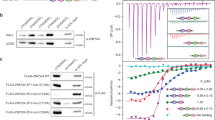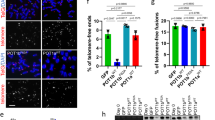Abstract
Distinct protein assemblies are nucleated at telomeric DNA to both guard the ends from damage and lengthen the DNA after replication. In yeast, Cdc13 recruits either Stn1-Ten1 to form a protective cap or the telomerase holoenzyme to extend the DNA. We have established an in vitro yeast telomere system in which Stn1-Ten1–unextendable or telomerase-extendable states can be observed. Both assemblies are Cdc13 dependent, as the Cdc13 C-terminal region supports Stn1-Ten1 interactions and the N-terminal region contains a telomerase-activation function. Notably, the yeast Hsp90 chaperone Hsp82 mediates the switch between the telomere capping and extending structures by modulating the DNA binding activity of Cdc13. Taken together, our data show that the Hsp82 chaperone facilitates telomere DNA maintenance by promoting transitions between two operative complexes and by reducing the potential for binding events that would otherwise block the assembly of downstream structures.
This is a preview of subscription content, access via your institution
Access options
Subscribe to this journal
Receive 12 print issues and online access
$189.00 per year
only $15.75 per issue
Buy this article
- Purchase on Springer Link
- Instant access to full article PDF
Prices may be subject to local taxes which are calculated during checkout







Similar content being viewed by others
References
Gilson, E. & Géli, V. How telomeres are replicated. Nat. Rev. Mol. Cell Biol. 8, 825–838 (2007).
DeZwaan, D.C. & Freeman, B.C. HSP90: the Rosetta stone for cellular protein dynamics? Cell Cycle 7, 1006–1012 (2008).
Lingner, J., Cech, T.R., Hughes, T.R. & Lundblad, V. Three ever shorter (EST) genes are dispensable for in vitro yeast telomerase activity. Proc. Natl. Acad. Sci. USA 94, 11190–11195 (1997).
Nugent, C.I., Hughes, T.R., Lue, N.F. & Lundblad, V. Cdc13p: a single-strand telomeric DNA-binding protein with a dual role in yeast telomere maintenance. Science 274, 249–252 (1996).
Grandin, N., Damon, C. & Charbonneau, M. Cdc13 cooperates with the yeast Ku proteins and Stn1 to regulate telomerase recruitment. Mol. Cell. Biol. 20, 8397–8408 (2000).
Chandra, A., Hughes, T.R., Nugent, C.I. & Lundblad, V. Cdc13 both positively and negatively regulates telomere replication. Genes Dev. 15, 404–414 (2001).
Pennock, E., Buckley, K. & Lundblad, V. Cdc13 delivers separate complexes to the telomere for end protection and replication. Cell 104, 387–396 (2001).
Lue, N.F. Sequence-specific and conformation-dependent binding of yeast telomerase RNA to single-stranded telomeric DNA. Nucleic Acids Res. 27, 2560–2567 (1999).
Gao, H., Cervantes, R.B., Mandell, E.K., Otero, J.H. & Lundblad, V. RPA-like proteins mediate yeast telomere function. Nat. Struct. Mol. Biol. 14, 208–214 (2007).
Grandin, N. & Charbonneau, M. Hsp90 levels affect telomere length in yeast. Mol. Genet. Genomics 265, 126–134 (2001).
Holt, S.E. et al. Functional requirement of p23 and Hsp90 in telomerase complexes. Genes Dev. 13, 817–826 (1999).
Toogun, O.A., DeZwaan, D.C. & Freeman, B.C. The Hsp90 molecular chaperone modulates multiple telomerase activities. Mol. Cell. Biol. 28, 457–467 (2008).
Kelleher, C., Kurth, I. & Lingner, J. Human protection of telomeres 1 (POT1) is a negative regulator of telomerase activity in vitro. Mol. Cell. Biol. 25, 808–818 (2005).
Mitton-Fry, R.M., Anderson, E.M., Theobald, D.L., Glustrom, L.W. & Wuttke, D.S. Structural basis for telomeric single-stranded DNA recognition by yeast Cdc13. J. Mol. Biol. 338, 241–255 (2004).
Niu, H., Xia, J. & Lue, N.F. Characterization of the interaction between the nuclease and reverse transcriptase activity of the yeast telomerase complex. Mol. Cell. Biol. 20, 6806–6815 (2000).
Wang, F. et al. The POT1–TPP1 telomere complex is a telomerase processivity factor. Nature 445, 506–510 (2007).
Wang, M.J. et al. Telomere-binding and Stn1p-interacting activities are required for the essential function of Saccharomyces cerevisiae Cdc13p. Nucleic Acids Res. 28, 4733–4741 (2000).
Puglisi, A., Bianchi, A., Lemmens, L., Damay, P. & Shore, D. Distinct roles for yeast Stn1 in telomere capping and telomerase inhibition. EMBO J. 27, 2328–2339 (2008).
Toogun, O.A., Zieger, W. & Freeman, B.C. The p23 molecular chaperone promotes functional telomerase complexes through DNA dissociation. Proc. Natl. Acad. Sci. USA 104, 5765–5770 (2007).
Dionne, I. & Wellinger, R.J. Cell cycle-regulated generation of single-stranded G-rich DNA in the absence of telomerase. Proc. Natl. Acad. Sci. USA 93, 13902–13907 (1996).
Bertuch, A.A. & Lundblad, V. The Ku heterodimer performs separable activities at double-strand breaks and chromosome termini. Mol. Cell. Biol. 23, 8202–8215 (2003).
Marcand, S., Brevet, V. & Gilson, E. Progressive cis-inhibition of telomerase upon telomere elongation. EMBO J. 18, 3509–3519 (1999).
Taggart, A.K., Teng, S.C. & Zakian, V.A. Est1p as a cell cycle-regulated activator of telomere-bound telomerase. Science 297, 1023–1026 (2002).
Teixeira, M.T., Arneric, M., Sperisen, P. & Lingner, J. Telomere length homeostasis is achieved via a switch between telomerase- extendible and -nonextendible states. Cell 117, 323–335 (2004).
Tseng, S.F., Lin, J.J. & Tseng, S.C. The telomerase-recruitment domain of the telomere binding protein Cdc13 is regulated by Mec1p/Tel1p-dependent phosphorylation. Nucleic Acids Res. 34, 6327–6336 (2007).
Li, S. et al. Cdk1-dependent phosphorylation of Cdc13 coordinates telomere elongation during cell-cycle progression. Cell 136, 50–61 (2009).
Arneriæ, M. & Lingner, J. Tel1 kinase and subtelomere-bound Tbf1 mediate preferential elongation of short telomeres by telomerase in yeast. EMBO J. 8, 1080–1085 (2007).
Zappulla, D.C., Roberts, J.N., Goodrich, K.J., Cech, T.R. & Wuttke, D.S. Inhibition of yeast telomerase action by the telomeric ssDNA-binding protein, Cdc13. Nucleic Acids Res. 37, 354–367 (2009).
Meier, B., Driller, L., Jaklin, S. & Feldmann, H.M. New function of CDC13 in positive telomere length regulation. Mol. Cell. Biol. 21, 4233–4245 (2001).
Freeman, B.C. & Yamamoto, K.R. Continuous recycling: a mechanism for modulatory signal transduction. Trends Biochem. Sci. 26, 285–290 (2001).
Wegele, H., Muller, L. & Buchner, J. Hsp70 and Hsp90—a relay team for protein folding. Rev. Physiol. Biochem. Pharmacol. 151, 1–44 (2004).
Picard, D. Intracellular dynamics of the Hsp90 co-chaperone p23 is dictated by Hsp90. Exp. Cell Res. 312, 198–204 (2006).
Friedman, K.L. & Cech, T.R. Essential functions of amino-terminal domains in the yeast telomerase catalytic subunit revealed by selection for viable mutants. Genes Dev. 13, 2863–2874 (1999).
Acknowledgements
We dedicate the present work to our enduring memories of Oyetunji A. Toogun. We thank J. Barral (University of Texas Medical Branch) for the CH184 Escherichia coli strain; V. Lundblad (Salk Institute) for the Cdc13 constructs; V. Zakian (Princeton University) for the CDC13-Myc9x and EST2-Myc9x yeast strains; D. Shore (University of Geneva) for Stn1 and Ten1 vectors; and A. Belmont, W. Brieher, P. Newmark and D. Rivier for helpful comments on the manuscript. D.C.D. was supported by a Cellular, Biochemical and Molecular Sciences training grant from the National Institutes of Health, and B.C.F. was supported by US Public Health Service grant DK074270.
Author information
Authors and Affiliations
Contributions
D.C.D. designed and conducted experiments, O.A.T. designed and conducted experiments, F.J.E. conducted experiments, and B.C.F. designed and conducted experiments and wrote the manuscript.
Corresponding author
Supplementary information
Supplementary Text and Figures
Supplementary Figures 1–5 (PDF 388 kb)
Rights and permissions
About this article
Cite this article
DeZwaan, D., Toogun, O., Echtenkamp, F. et al. The Hsp82 molecular chaperone promotes a switch between unextendable and extendable telomere states. Nat Struct Mol Biol 16, 711–716 (2009). https://doi.org/10.1038/nsmb.1616
Received:
Accepted:
Published:
Issue Date:
DOI: https://doi.org/10.1038/nsmb.1616
This article is cited by
-
The HSP90 chaperone machinery
Nature Reviews Molecular Cell Biology (2017)
-
Functional characterisation of long intergenic non-coding RNAs through genetic interaction profiling in Saccharomyces cerevisiae
BMC Biology (2016)
-
Modulation of yeast telomerase activity by Cdc13 and Est1 in vitro
Scientific Reports (2016)
-
Proteomics of yeast telomerase identified Cdc48-Npl4-Ufd1 and Ufd4 as regulators of Est1 and telomere length
Nature Communications (2015)
-
Telomere length regulation: coupling DNA end processing to feedback regulation of telomerase
The EMBO Journal (2009)



